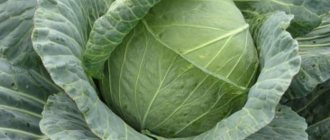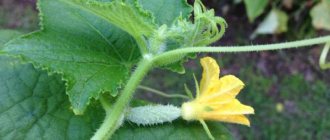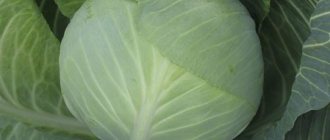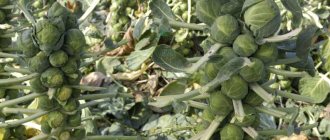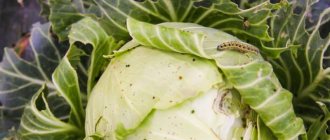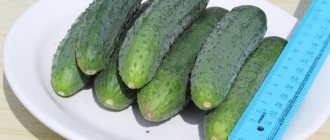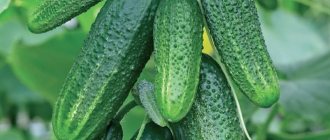Vegetable growing » Cabbage
0
1160
Article rating
Kira Stoletova
Excellent transportability, impressive head size, stable yield and ease of processing - these are the properties of Krautkaiser f1 cabbage. This European hybrid vegetable is adapted to growing in temperate climates.
Characteristics of Krautkaiser cabbage variety
Description of Krautkaiser cabbage
The hybrid cabbage variety was bred by Dutch breeders of the company BEJO ZADEN BV. It grows best in a climate of moderate temperatures. It has been cultivated in the Russian Federation since 1993. Main regions for growing the variety:
- Nizhnevolzhsky;
- Ural;
- Volgo-Vyatsky;
- West Siberian;
- East Siberian;
- Far Eastern;
- Central;
- Northern;
- Northwestern.
The Krautkaiser variety has a lot of useful characteristics, thanks to which it is very popular among vegetable growers.
The ripening period for cabbage is medium-late. The harvest is ready for harvest 100-120 days after planting the seedlings in the ground. In some regions, the ripening period lasts from 125 days to 150 days. This is due to weather conditions.
The plant is powerful and non-lodging. The rosette of the variety is quite large, but compact and sparsely leafy. A distinctive feature of the leaf cover is that cabbage suppresses weeds well, which reduces the number of weedings during the season.
The head of cabbage is of the correct shape. Flat-round or oval shapes may occur. The color of a head of Krautkaiser cabbage when cut is white, the structure is dense and well developed. The plugs are free of voids and filled evenly. The average weight of the heads is 3-4 kg. The inner stalk is of normal length, the outer one is much shorter.
Cabbage leaves are medium sized, semi-raised. Their shape is ovoid, the color is light green, with a slight blue tint.
The amazing color of the leaves adds a decorative touch to Krautkaiser cabbage beds
The surface of the leaves is smooth, with a slight waxy coating, the edges are not wavy. The leaves are juicy and have a pleasant taste.
The Krautkaiser variety is highly adaptable to climate conditions. Grows well in unstable temperatures, tolerates high and low temperatures with equal stability.
If storage requirements are met, Krautkaiser shows average shelf life - up to 4 months. The transportability of the hybrid is excellent and is suitable for mechanical processing.
The variety is grown on an industrial scale.
Features of agricultural technology
Sowing seeds: timing and rules
Seeds are planted in soil poured into wooden boxes or other containers in early April. Grooves are made in the soil. The seeds are buried in them by 10 mm, the distance is maintained at about 30 mm.
The planted material is sprinkled with earth, watered and compacted (lightly). Cover the box with plastic wrap.
On the 6th (sometimes 5) day the first shoots will appear. Picking is done after the formation of two leaves. Then the seedlings are placed in pots.
A few weeks before the planned transplantation of cabbage into open ground, the plants are hardened off. The pots are taken outside for a while each day to acclimate to the wind and natural light.
Planting seedlings in the ground
It is recommended to transplant seedlings into open soil in late May. Planting pattern - 50x50 cm. It is optimal to grow Krautman on fertile loamy lands that previously contained legumes or pumpkin crops.
Small holes are prepared in the ground and filled with water. The roots of the seedlings are lowered into the soil, sprinkled, the earth is compacted and watered. For the first 3–5 days, it is advisable to shade the seedlings so that the sun's rays cannot negatively affect fragile plants.
Caring for Krautman cabbage
The hybrid loves moisture. Therefore, it should be watered regularly. For the first time, the soil is irrigated with water with potassium permanganate added to it (you should get a weak solution with a slightly pink tint).
Subsequently, watering is carried out in the evening or in the morning with settled warm liquid every few days. For 1 square of crops, 12 liters of water are needed. Watering is made more intense when tying cabbage heads.
The hybrid needs fertilizing, which significantly increases productivity. The first is performed 15–20 days after transplanting the seedlings. The second one is made after another 3 weeks.
Mullein plant
For the first feeding, use an infusion of mullein (for 1 part take 8 parts of water) or bird droppings (1 to 12). Each seedling requires about 500 mg of the prepared solution.
Similar infusions are used for the second feeding. But in this case, you need to fertilize the cabbage with a large amount of the mixture (1 l).
High-quality plant care involves spraying its leaves with a special mixture (the procedure is called foliar feeding). For 10 liters of water take:
- superphosphate – 4 g;
- urea – 60 g;
- vitamin C – 1 g.
The leaves are treated with this solution every three weeks. Starting from the third feeding, 20–30% less urea is added to the water.
Full development and growth of seedlings is impossible without periodic loosening of the soil. This simple operation provides the cabbage roots with moisture and oxygen.
Loosening is carried out to a depth of 5 cm with a hoe. At the same time, weeds are removed. If desired, you can lay a layer of peat on the loosened soil, which will eliminate the risk of the reappearance of foreign grass.
Hilling should be done twice a season. The procedure allows the hybrid to sprout additional fresh roots. Through them, more nutrients will reach the crop.
Protecting crops from diseases
During the growing process, Krautman can be affected by parasites and diseases inherent in all varieties of white cabbage. The hybrid suffers from:
- Cabbage fly. Symptoms of the disease are wilting of the leaves, the appearance of purple and lilac spots on them. The fight against the scourge is to remove the larvae manually, and treat the crops with burdock infusion.
- Black leg. The infected part of the plant begins to rot. Solutions of vitriol (5 g of product plus 10 liters of clean water) and Bordeaux mixture (1 percent) can cope with the problem. They treat the lesion. Before this, the diseased seedling is pulled out of the ground.
- Cruciferous flea beetle. Symptoms are the appearance of holes on the surface of the leaves. You can get rid of flea beetles by spraying an infusion of garlic, tobacco, or regular chamomile over the plant.
- Keelas. The disease manifests itself by wilting and falling of cabbage leaves and the subsequent cessation of growth of the latter. Protection against clubroot - fertilizing the soil with wood ash.
Cabbage fly
Harvest time and storage of heads of cabbage
Cabbage becomes technically ripe 120–140 days after the first shoots. From 1 square meter of land, up to 9 kg of crop is collected.
The longest shelf life of a vegetable without additional processing is 4–5 months. The variety is suitable for salting and pickling.
By following simple standards for planting and caring for the Krautman hybrid, any amateur gardener is able to provide himself and his family with fresh and sauerkraut, rich in vitamins and elements important for humans, until the next harvest.
Pros and cons of Krautkaiser cabbage
It cannot be said that all vegetable growers like the variety. However, those who grew Krautkaiser highlight a whole list of its advantages:
- Excellent adaptation of cabbage to environmental conditions and climate. Consistently good attitude to heat and cold.
- Heads of cabbage do not crack even with high humidity.
- Large-fruited variety.
- Stable immunity to major crop diseases.
- The density of the heads allows cabbage to be transported over long distances without damage.
- High yield of the variety on different soils.
- Versatility of use.
Some shortcomings are also noted that prevented the Krautkaiser variety from becoming everyone's favorite. They appear only in the presence of violations:
- Agricultural technicians. In this case, the cabbage is affected by a fungal infection - clubroot.
- Storage rules. The shelf life of cabbage, which is already considered average (no more than 4 months), is reduced.
Another disadvantage is the average frost resistance of the variety. It does not allow growing a good harvest in areas with harsh winters.
Reviews
- Sergey from Belgorod. Cabbage is a vegetable that takes pride of place in my garden. I have been growing the described hybrid for the 3rd year. I'm always pleased with the result. The heads of cabbage are large and very tasty. With all its advantages, the variety is unpretentious. Last summer there was unrealistic heat and, accordingly, drought. However, this fact did not significantly affect the quality and quantity of the harvest.
- Valentina from Tula. The presented cabbage appeared in my beds last season – I purchased seedlings at the market. I liked the hybrid. The heads of cabbage turned out to be large and juicy. I started cutting the crop in August and finished it just before the cold weather. Despite being in the garden for a long time, not a single head of cabbage cracked. I cooked in all forms: fried, stewed, fermented. I liked the cabbage the most in the last version.
Krautkaiser cabbage literally translates as “Cabbage King.” The hybrid fully lives up to its name. Unpretentiousness in cultivation, together with other positive characteristics, have made the variety popular among both professionals and amateurs.
Yield of cabbage Krautkaiser F1
The originators have planned for the high yield of the variety. It is this parameter that attracts farmers. If the requirements of agricultural technology are met and the weather is favorable, then you can harvest 8-13 kg of the Krautkaiser variety from 1 sq. m. Another factor that distinguishes cabbage is the uniform ripening of the forks and excellent presentation.
If you follow all the rules of care, you can reap a large harvest from a small area.
Planting and caring for Krautkaiser cabbage
The description of the variety indicates its heat requirements and average frost resistance. Therefore, Krautkaiser is almost never grown by direct sowing into the ground. The best option is the seedling method. It gives maximum results, although it requires effort. To grow high-quality cabbage seedlings, you need to perform certain actions:
- Purchase certified planting material and prepare it for sowing. The seeds of the Krautkaiser hybrid are characterized by high germination, the first shoots appear 6-7 days after sowing.
- Determine the time for sowing. Krautkaiser cabbage is sown for seedlings in the 2nd decade of April.
- Prepare the seeds. To do this, wrap them in a wet cloth, the temperature of the water for soaking is + 45-50 °C. Leave for 25 minutes, rinse with cold water and place in a stimulating solution for 12 hours. Then you will have to harden it in the refrigerator for 2-3 days. During the day, Krautkaiser seeds are in the room, at night they are sent to the refrigerator
- Prepare the container and soil mixture. It is recommended to take separate cups for sowing. Soil for seedlings can be purchased ready-made or you can mix turf soil with humus in equal quantities yourself. It is useful to add 1 cup of wood ash. Calcine the soil or spill it with a solution of potassium permanganate.
- Fill the cups with a 7 cm layer of soil mixture, bury the cabbage seeds 1.5 cm, and moisten with a spray bottle.
- Cover the crops with film and place them in a warm place with good lighting and an air temperature of at least + 18-23 °C.
- As soon as the seedlings of the Krautkaiser variety hatch, remove the film and reduce the temperature to + 15-18 °C.
As soon as the seedlings hatch, you need to move the container to the light so that they do not stretch out
When caring for seedlings, you need to optimize watering - monitor the level of drying of the top layer of soil. Excessive moistening of Krautkaiser cabbage seedlings will lead to rotting of the stem and root system. To prevent it from stretching, it is necessary to provide good lighting for 14-15 hours. When sowing in a large planting box, be sure to dive the seedlings of the variety. This must be done at the stage of two full leaves, and the seedling should be buried down to the cotyledon leaves. 14 days before planting, begin hardening off the cabbage seedlings by taking the container outside.
Prepare the bed in advance. Krautkaiser cabbage grows well in medium-neutral soil, nutritious and loose. Optimally - black soil or loam. Choose a sunny place, best after potatoes, cucumbers or legumes. Dig up, fill with compost or humus. Cabbage seedlings are ready for planting 35 days after sowing - all of May, depending on the weather and climatic conditions.
Make holes in the garden bed according to the pattern 50×50 cm or 60×40 cm, transfer the seedlings together, cover them with nutritious soil, and water them.
Caring for the Krautkaiser variety is not difficult, but the main points must be followed:
- Watering.
Cabbage is very moisture-loving, so you will have to water the plants all season. Seedlings are moistened 2-3 times a week, taking into account weather conditions. It is important to focus on watering when cabbage heads begin to form. Only with constant soil moisture does Krautkaiser form large heads. But at the moment of their ripening, stop watering so that the heads of cabbage do not crack. Important! When irrigating, avoid getting moisture on the leaves. - Feeding. In early June, Krautkaiser cabbage needs nitrogen, so it is recommended to use an ammonium nitrate solution or an infusion of bird droppings. The second time nutrition is needed is when the heads are formed. The mineral composition is made per 10 liters of water. You will need superphosphate (5 g), urea (4 g), potassium sulfate (8 g). You need to pour 2 liters of the composition onto one plant. A popular recipe is to sprinkle the circle around the trunk with ash.
- Weeding and loosening. They are especially important at the beginning of the growing season so that weeds do not overshadow the Krautkaiser cabbage. Then the variety itself suppresses weeds. Loosening can be continued until the end of the season.
Loosening and weeding significantly improve the quality of the variety's heads
- Hilling. This procedure will strengthen the cabbage root system and increase yield. It is more convenient to carry it out after rain. For this variety, hilling is recommended 2 times with an interval of 3 weeks.
The harvest should be harvested on a sunny, dry day. Then sort out the heads of cabbage and send them for storage.
Growing technology
When planting Krautkaiser cabbage, it is necessary to correctly select and prepare the place and planting material, observe the sowing dates and provide the crop with proper care.
Optimal conditions
Despite his unpretentiousness in soil composition, Krautkaiser prefers nutritious, light, loose soil with a medium or neutral acidity level.
The best option is loam or black soil. In the fall, the area is loosened, dug up with a shovel, and fed with mineral fertilizers, humus or compost.
The planting site should be sunny, open, protected from drafts and cold winds. The best predecessors are legumes, cucumbers and potatoes.
Before sowing, the seeds are wrapped in gauze for 20-25 minutes. lowered into a warm place (+45…+50°C), and then for 2-3 minutes. into cold water. After this, the planting material is soaked for 12 hours in a solution of a growth stimulator (Kornevin, Epin), after swelling, it is again wrapped in gauze and put in the refrigerator overnight. For 2-3 days, the seeds are kept at room temperature during the day and placed in the cold at night.
To grow seedlings, use a substrate consisting of equal parts of humus and turf soil with the addition of wood ash. To disinfect it, it is calcined in advance for half an hour in the oven at a temperature of +180°C or spilled with a pale pink solution of potassium permanganate.
Landing dates and rules
Seeds for seedlings are sown in mid-April. The prepared substrate is poured into containers with a layer of 7-8 cm, depressions of 1-1.5 cm are made on the surface, seeds are placed in them, covered with soil on top and watered generously with a spray bottle.
Cover the container with polyethylene and put it in a bright place at a temperature of +18…+23°C. After 5-7 days, when shoots appear, the shelter is removed and for 13-15 hours the seedlings are transferred to a cooler place with a temperature of +15...+19°C.
When two full-fledged leaves are formed on the seedlings, the seedlings are planted, burying the cotyledon leaves into the soil.
15 days before transplanting seedlings into the ground, they begin to harden them. To do this, containers with seedlings are taken out onto the street or balcony every day, first for 5-6 hours, gradually increasing this time.
30-35 days after sowing the seeds, the seedlings are planted in open ground. Depending on the climate of the region, this time falls at the beginning, middle or end of May.
Landing rules:
- Form rows on the prepared area at a distance of 50-60 cm from each other.
- Dig planting holes in them every 40-50 cm.
- Water them generously with settled warm (+18…+20°C) water.
- Remove the seedlings from the container along with a lump of earth and place them in the holes.
- Cover the plants with nutritious soil and water generously.
The optimal planting density of Krautkaiser is 30-35 thousand per 1 hectare.
Further care
Within 2-3 weeks after transplanting the seedlings into the ground, it is watered 2-3 times a week. Then watering is carried out once every five days, in case of hot and dry weather - every three days.
The soil must be constantly moistened by at least 80% - this is necessary for the formation of large heads of cabbage. During the period of maturation of the heads, watering is stopped to avoid their cracking.
The soil is loosened weekly. For the first time to a depth of 4-5 cm, then 7-8 cm. This improves access of oxygen and moisture to the roots, enriches the soil with nutrients, activates the growth of greenery and avoids the formation of a dry crust on the soil surface.
Cabbage is hilled twice a season - after the formation of small heads and 2-3 weeks after that. The procedure is carried out after rain or watering, raking the soil up to the trunk to the level of the first full-fledged leaves. The soil between the rows is sprinkled with wood ash.
Fertilizers are applied at least twice per season:
- 15 days after transplanting the seedlings - a solution of ammonium nitrate (10 g per 10 liters of water);
- period of setting heads - 8 g of potassium sulfate, 5 g of double superphosphate and 4 g of urea, diluted in 10 liters of water.
Possible problems, diseases, pests
Cabbage can be affected by:
- Clubroot is a fungal disease that affects the roots of plants causing growths to appear on them;
- peronosporosis (downy mildew) - white spots appear on the underside of cabbage leaves, which over time spread over the entire surface of the leaf blades.
To prevent diseases, the soil on the site is limed, regularly loosened and weeded, the level of soil moisture is monitored and treated with fungicidal preparations - “Fitosporin”, “Oxychom”, “Abiga-Peak”.
Pests dangerous to Krautkaiser are flea beetles, aphids and cabbage flies. To get rid of insects, plantings are treated with ash decoction and insecticides, for example, “Bazudin”, “Iskra-M”, “Senpai”, “Fufanon”, “Inta-Vir”.
Diseases and pests
Hybrid Krautkaiser has varying degrees of disease resistance. For example, it is not affected by point necrosis and fusarium. But you can get sick with rot (white and gray), clubroot, downy mildew or bacteriosis. This happens when the rules of agricultural technology are violated.
Clubroot is characterized by growths on the roots.
Infection can be prevented by liming the soil
Downy mildew affects not only the leaves, but also other parts of Krautkaiser cabbage.
Bacteriosis makes cabbage unsuitable for use
The most common pests are flea beetles, cabbage flies and aphids.
Pests have to be fought with insecticides
